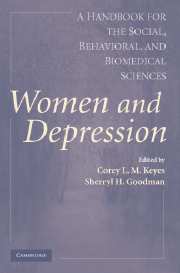Book contents
- Frontmatter
- Contents
- List of Contributors
- Foreword
- Preface
- PART I NOSOLOGY, MEASUREMENT, AND THE EPIDEMIOLOGY OF WOMEN AND DEPRESSION
- PART II BIOLOGICAL, DEVELOPMENTAL, AND AGING MODELS OF RISK
- PART III COGNITIVE, EMOTIONAL, AND INTERPERSONAL MODELS OF RISK
- 7 Cognition and Depression
- 8 Personality and Depression in Women
- 9 The Social Costs of Stress
- 10 Marriage and Depression
- 11 Depression in Women Who Are Mothers
- PART IV SOCIAL, POLITICAL, AND ECONOMIC MODELS OF RISK
- PART V SYSTEMS AND PROCESSES OF TREATMENT, PREVENTION, AND POLICY
- Author Index
- Subject Index
- References
9 - The Social Costs of Stress
How Sex Differences in Stress Responses Can Lead to Social Stress Vulnerability and Depression in Women
Published online by Cambridge University Press: 05 June 2012
- Frontmatter
- Contents
- List of Contributors
- Foreword
- Preface
- PART I NOSOLOGY, MEASUREMENT, AND THE EPIDEMIOLOGY OF WOMEN AND DEPRESSION
- PART II BIOLOGICAL, DEVELOPMENTAL, AND AGING MODELS OF RISK
- PART III COGNITIVE, EMOTIONAL, AND INTERPERSONAL MODELS OF RISK
- 7 Cognition and Depression
- 8 Personality and Depression in Women
- 9 The Social Costs of Stress
- 10 Marriage and Depression
- 11 Depression in Women Who Are Mothers
- PART IV SOCIAL, POLITICAL, AND ECONOMIC MODELS OF RISK
- PART V SYSTEMS AND PROCESSES OF TREATMENT, PREVENTION, AND POLICY
- Author Index
- Subject Index
- References
Summary
Men and women differ in their mental and physical disease vulnerability, and sex differences appear to matter in the biological contributions to human health (Institute of Medicine, 2001). With respect to depression, approximately 12 million women in the United States experience depression annually, a rate of diagnosis that is at least twice the frequency of that found among men (National Mental Health Association, 2004). Although genetic factors, including sex, certainly play a role in the development of psychiatric illness, we now know that genotype alone does not singly determine whether an individual will develop a given psychiatric disorder (Plomin, DeFries, Craig, & McGuffin, 2003). For example, although there are well-known familial risks and sex differences in the prevalence rates of schizophrenia, depression, anxiety, and attention deficit/hyperactivity disorder (ADHD) (American Psychiatric Association, 1994), recent data suggest that environmental and biological factors, including stress, age, social support, and socioeconomic status, also contribute to the expression of these disorders (e.g., depression, anxiety, and posttraumatic stress disorder (PTSD); Kubzansky, Berkman, & Seeman, 2000; McEwen, 1998; Sapolsky, 1994; Vinokur, Price, & Caplan, 1996). A recent report proposes that there are sex differences in biological and behavioral responses to stress — the tend-and-befriend response (Taylor, Klein, Lewis, Gruenewald, Gurung, & Updegraff, 2000) – and suggests that social stressors may influence the manifestation of some psychiatric disorders, such as depression, differently in men and women (Klein & Corwin, 2002).
- Type
- Chapter
- Information
- Women and DepressionA Handbook for the Social, Behavioral, and Biomedical Sciences, pp. 199 - 218Publisher: Cambridge University PressPrint publication year: 2006



